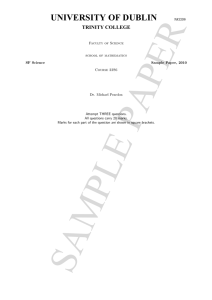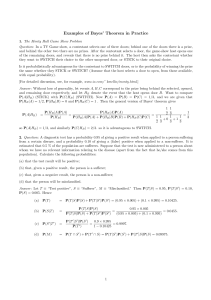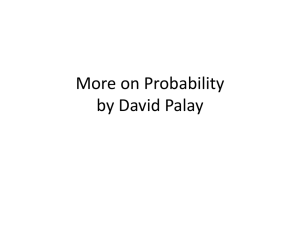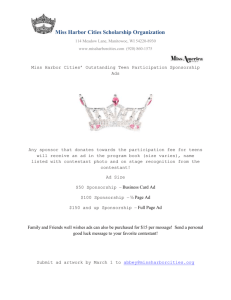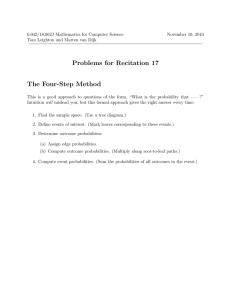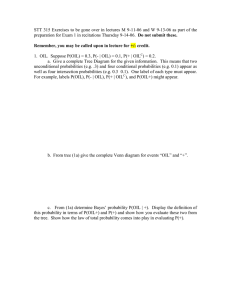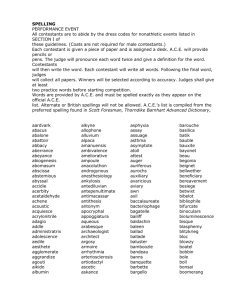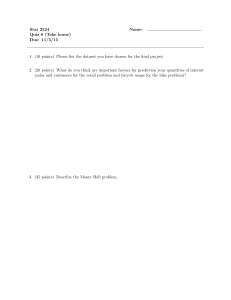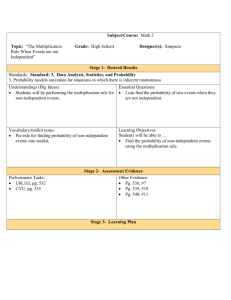CS 171 Lecture Outline Introduction to Probability
advertisement
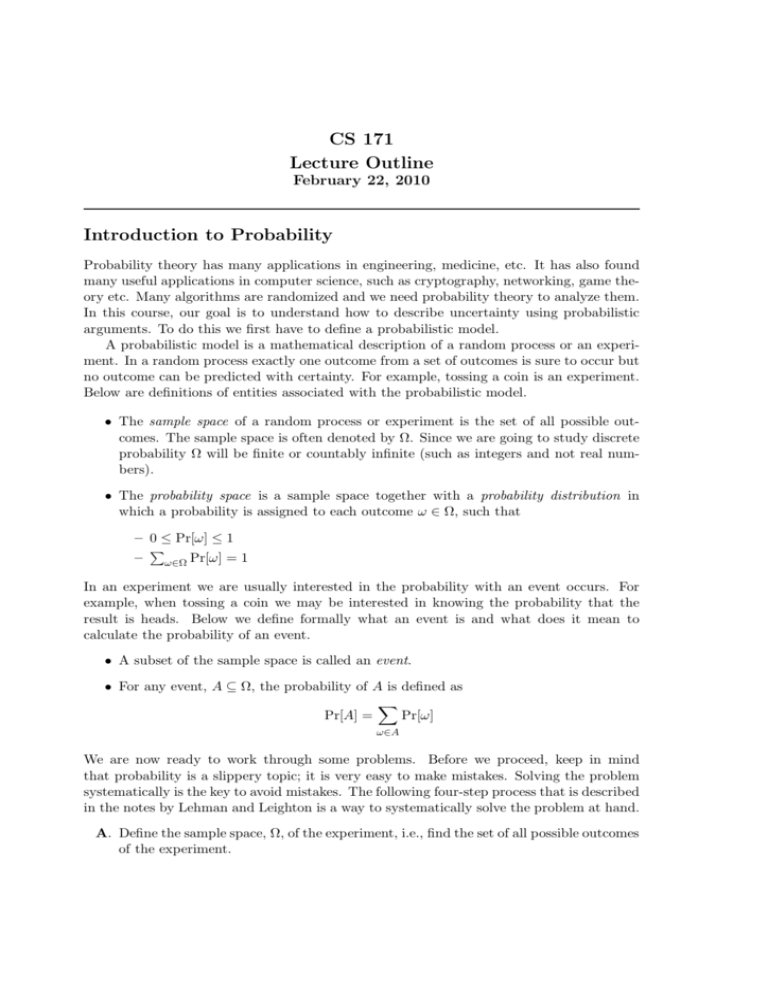
CS 171
Lecture Outline
February 22, 2010
Introduction to Probability
Probability theory has many applications in engineering, medicine, etc. It has also found
many useful applications in computer science, such as cryptography, networking, game theory etc. Many algorithms are randomized and we need probability theory to analyze them.
In this course, our goal is to understand how to describe uncertainty using probabilistic
arguments. To do this we first have to define a probabilistic model.
A probabilistic model is a mathematical description of a random process or an experiment. In a random process exactly one outcome from a set of outcomes is sure to occur but
no outcome can be predicted with certainty. For example, tossing a coin is an experiment.
Below are definitions of entities associated with the probabilistic model.
• The sample space of a random process or experiment is the set of all possible outcomes. The sample space is often denoted by Ω. Since we are going to study discrete
probability Ω will be finite or countably infinite (such as integers and not real numbers).
• The probability space is a sample space together with a probability distribution in
which a probability is assigned to each outcome ω ∈ Ω, such that
– 0 ≤ Pr[ω] ≤ 1
P
–
ω∈Ω Pr[ω] = 1
In an experiment we are usually interested in the probability with an event occurs. For
example, when tossing a coin we may be interested in knowing the probability that the
result is heads. Below we define formally what an event is and what does it mean to
calculate the probability of an event.
• A subset of the sample space is called an event.
• For any event, A ⊆ Ω, the probability of A is defined as
X
Pr[A] =
Pr[ω]
ω∈A
We are now ready to work through some problems. Before we proceed, keep in mind
that probability is a slippery topic; it is very easy to make mistakes. Solving the problem
systematically is the key to avoid mistakes. The following four-step process that is described
in the notes by Lehman and Leighton is a way to systematically solve the problem at hand.
A. Define the sample space, Ω, of the experiment, i.e., find the set of all possible outcomes
of the experiment.
2
Lecture Outline
February 22, 2010
B. Define the probability distribution.
C. Find the event of interest, A, i.e., find the subset of outcomes, A ⊆ Ω that are of
interest.
D. Compute the probability of A by adding up the probabilities of the outcomes in A.
Example 1.
Solution.
On flipping a fair coin what is the probability that the result is heads?
Ω = {H, T }, Pr[H] = Pr[T ] = 1/2, A = {H}, Pr[A] = 1/2.
Example 2. Consider a biased coin in which the probability of heads is 1/3. Suppose we
flip the coin twice. What is the probability that we obtain one tails and one heads?
Solution.
Ω = {HH, HT, T H, T T }. The probability distribution is given by
Pr[HH] =
Pr[HT ] =
Pr[T H] =
Pr[T T ] =
1
3
1
3
2
3
2
3
1
3
2
×
3
1
×
3
2
×
3
×
1
9
2
=
9
2
=
9
4
=
9
=
Note that the assigned probabilities form a valid probability distribution. Event A =
{HT, T H}. The probability of the event A is given by
Pr[A] = Pr[HT ] + Pr[T H] =
4
9
Example 3. We roll two dice. Compute the probability that the two numbers are equal
when (i) two dice are distinct, (ii) the dice are indistinguishable.
Solution. (a) Each outcome of the experiment can be denoted by an ordered pair (ω1 , ω2 ), 1 ≤
ω1 , ω2 ≤ 6, where ω1 and ω2 are the numbers on dice 1 and dice 2 respectively. Note that
|Ω| = 36 and each outcome is equally likely. The event that the two numbers are equal
is given by A = {(1, 1), (2, 2), (3, 3), (4, 4), (5, 5), (6, 6)}. The probability that A occurs is
given by
6
1
|A|
=
=
Pr[A] =
|Ω|
36
6
(b) When the die are indistinguishable, the order of the two numbers is not important,
hence each outcome of the experiment can be denoted by a 2-set {ω1 , ω2 }, 1 ≤ ω1 , ω2 ≤ 6,
where ω1 and ω2 are the numbers on the two die. Note that |Ω| = 21. Each outcome of
1
2
= 18
and outcomes of the form
the form {ω1 , ω2 }, ω1 6= ω2 occurs with a probability of 36
1
{ω, ω} occur with the probability of 36 . The event that the two numbers are equal is given
February 22, 2010
Lecture Outline
3
by A = {{1, 1}, {2, 2}, {3, 3}, {4, 4}, {5, 5}, {6, 6}}. The probability that A occurs is given
by
1
1
=
Pr[A] = 6 ×
36
6
Example 4. Suppose we throw m distinct balls into n distinct bins. Assume that there
is no bound on the number of balls that a bin contains. What is the probability that a
particular bin, say bin 1, contains all the m balls?
Solution. Each outcome can be represented by a m-tuple (ω1 , ω2 , . . . , ωm ), where ωi
denotes the bin that contains the ith ball. Note that |Ω| = nm and each outcome is equally
likely. Since there is only one way in which all balls can be in bin 1, the probability of this
event is n1m .
Example 5. On “Let’s Make a Deal” show, there are three doors. There is a prize behind
one of the doors and goats behind the other two. The contestant chooses a door. Then the
host opens a different door behind which there is a goat. The contestant is then given a
choice to either switch doors or to stay put. The contestant wins the prize if and only if
the contestant chooses the door with the prize behind it. Is it to the contestant’s benefit
to switch doors?
Solution. Each outcome of the sample space can be denoted by a 3-tuple (ω1 , ω2 , ω3 ),
where ω1 denotes the door hiding the prize, ω2 denotes the door chosen by the contestant
initially, and ω3 is the door chosen by the host. Now, lets assign probabilities to each of the
outcomes1 . There are two types of outcomes, those in which ω1 = ω2 and those in which
ω1 6= ω2 . It is easy to verify that there are 6 outcomes of each type. Each outcome of the
1
. If the outcome is of the second type
first type occurs with a probability of 31 × 13 × 12 = 18
then there is only one choice for ω3 , i.e., there is only one choice of door for the host. Each
outcome of the second type occurs with a probability 31 × 31 × 1 = 91 . The event in which
the contestant switches doors and wins is the set of all outcomes in which ω1 6= ω2 . Since
the size of this set is 6 and each outcome occurs with a probability of 19 the probability of
the contestant winning the prize by switching is 96 = 23 . Thus, it is to contestant’s benefit
to switch.
Please read notes by Lehman and Leighton for a detailed explaination of the solution
using a tree diagram.
Example 6. What is the probability of rolling a six-sided die six times and having all
the numbers 1 through 6 result (in any order)?
Solution. Each element in Ω can be represented by (ω1 , ω2 , . . . , ω6 ), where ωi is the
number that results on the ith roll of the die. Using the multiplication rule we get |Ω| = 66 .
Let A ⊆ Ω be the set of outcomes in which the numbers of the rolls are different. By
1
We are making the following assumptions:(i) the prize is equally likely to be behind any of the doors,
(ii) the contestant is equally likely to choose any of the three doors, (iii) the host opens any of the possible
doors with equal probability
4
Lecture Outline
February 22, 2010
multiplication rule |A| = 6!. Since each outcome is equally likely, the desired probability is
given by
6!
5
|A|
= 6 =
|Ω|
6
324
